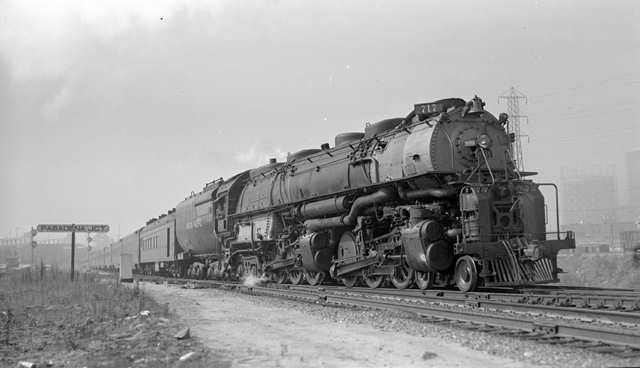Garrattfan's Modelrailroading Pages

My collection
Union Pacific Challenger 4-6-6-4
The prototype

Union Pacific Railroad #3935 hauls train No. 717, the Los Angeles Challenger across the Pasadena Junction in Los Angeles, California on August 1, 1940. (Photo Otto Perry under Fair use policy © Denver Public Library)
In the 1930s the Union Pacific Railroad needed a more powerful locomotive to get trains over the rugged grades of the Wahstach Mountains. So far helpers were needed, increasing cost and slowing speed. Based on an existing 4-12-2 a design was suggested with the six sets of drivers split into two groups of three and with two groups of cylinders. Boiler and firebox were enlarged and two trucks were added. Crossing the Wahstach mountains was considered a challenge giving this new wheel arrangement its name. The first 4-6-6-4, UP number 3900, entered service in 1936. The new type proved to be a well balanced design, running steadily at high speeds (unusual for Mallets). UP decided to assign ten Challengers for passenger services. They were painted in the corresponding color scheme and were fitted with smoke deflectors. 252 Challengers were built until as late as 1947.
3977 at Cody Park (source unknown, please contact me if you find your photo
here)
Only two survived UP 3977, one of the passenger version, and UP 3985 currently the largest operational steam locomotive in the world. More on Challengers in general on Steam Locomotives
Note: locomotives like the Challenger are often referred to as Mallets. Strictly speaking this is not the case. These locomotives are articulated conform the Mallet system. They do not use compound expansion however, which explicitly was part of the Mallet patent, and both sets of cylinder are fed with live steam directly from the boiler.
The model
Actually the Rivarossi model is not a beauty. It does not reflect the shear
beauty and balance that the prototype radiates. Rods and valves are crude and
shiny. The wheels are nowhere near a good resemblance, let alone the RP25 standard.
The measure of detail is not much better than the Revell
Big Boy. The motor is awkwardly protruding from the back of the driver cab
and details like handrails are made of too shiny chromed wire. Its running capabilities
are limited. When I first tried it, it wouldn't even run. Only after some tweaking
and tuning I could convince this model to move.
This model is one of the very few buys I regret. The only reason I bought it
was the color scheme. Never in my life had I seen this pretty scheme and it
suits the Challenger excellently. Until I saw this copy, I hadn't even noticed
the existence of this color scheme.

Sign my
GuestBook